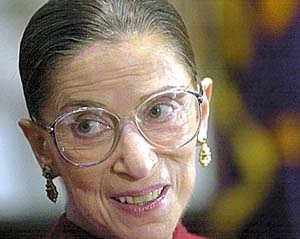

Tucson, Arizona Sunday, 10 August 2003
 Ruth Bader Ginsburg |
By Anne Gearan
THE ASSOCIATED PRESS
WASHINGTON - Supreme Court Justice Ruth Bader Ginsburg is all business during
the court's public sessions. She zeroes in on lawyers who haven't done their
homework and her careful, reedy tone can quickly undercut some of her more flamboyant
colleagues on the bench.
A few in the courtroom, however, briefly see a very different side of the Supreme
Court's second female justice, whose 10th anniversary on the court is today.
Woman lawyers taking their oaths as members of the Supreme Court Bar often see
a broad grin on Ginsburg's thin face when they rise for an introduction to the
court.
Ginsburg gained national prominence arguing, and winning, women's rights cases
before the Supreme Court and elsewhere. She was a long-serving federal judge
when President Bill Clinton picked her as his first Supreme Court appointment
in 1993.
The first justice chosen by a Democratic president in dec-ades, Ginsburg votes
most often with the court's more liberal wing. That means she frequently is
on the losing side when the court splits 5-4 along ideological lines.
Ginsburg, 70, has emerged as a quiet peacemaker on the court, a liberal whom
conservatives on and off the court can admire, said Douglas Kmiec, a conservative
constitutional scholar at Pepperdine University's law school.
Ginsburg usually sticks to the narrow meaning of laws and tries to keep the
court's nose out of problems that can be solved elsewhere, Kmiec and other law
professors said. That cautious approach sometimes means she puts her own views
aside.
"She always uses the phrase, 'Get it right,' " said W. William Hodes,
an Indianapolis lawyer and a former Ginsburg law clerk. "Part of getting
it right means not always voting for what you personally think is correct."
Ginsburg had no such quandary in the case for which she is probably best known.
She wrote the 1996 ruling that forced the tax-supported Virginia Military Institute
to open its doors to women.
Ginsburg might have used the opportunity to revel in what must have seemed
a crowning moment in her own career as a women's rights lawyer, but the ruling
contains no gloating.
"Women seeking and fit for a VMI-quality education cannot be offered anything
less, under the state's obligation to afford them genuinely equal protection,"
Ginsburg wrote.
She declined to be interviewed for this story.
As a student at Harvard Law School, Ginsburg once was asked how she could justify
occupying a spot that could otherwise have gone to a man. She tried to avoid
a confrontation by noting that her husband was also enrolled there. After graduation
she has said she found elite legal circles largely closed to "a woman,
a Jew and a mother to boot."
Although less recognizable than the court's first female justice, Sandra Day
O'Connor, Ginsburg is one of the more visible members. She frequently gives
speeches and turns up in unexpected places - a bit player in an opera and astride
an elephant during a tour of India with Justice Antonin Scalia.
At the court, Ginsburg is known as a demanding boss who prides herself on producing opinions quickly. Cases often depend on the vote of O'Connor or fellow center-right "swing voter" Anthony M. Kennedy. Conservative firebrand Scalia and civil rights iconoclast Clarence Thomas are more likely to grab headlines.